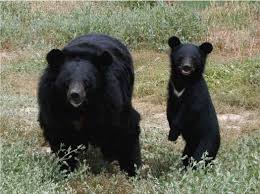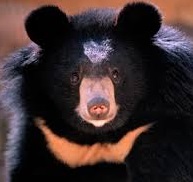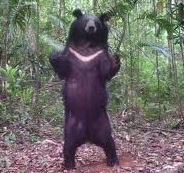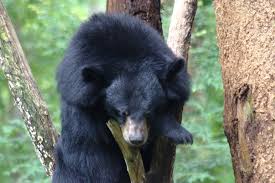The Asian black bear (Ursus thibetanus, previously known as Selenarctos thibetanus) is also known as moon
bear, Asiatic black bear and white-chested bear. It is a medium-sized bear species and largely adapted to
arboreal life. It lives in the Himalayas, in the northern parts of the Indian subcontinent, Korea,
northeastern China, the Russian Far East, the Honsh and Shikoku islands of Japan, and Taiwan. It is
classified as vulnerable by the International Union for Conservation of Nature (IUCN), mostly because of
deforestation and hunting for its body parts.
The species is morphologically very similar to some prehistoric bears, and is thought by some scientists to
be the ancestor of other extant bear species (aside from pandas and spectacled bears). Though largely
herbivorous, Asian black bears can be very aggressive toward humans, who frequently trap or kill them for
traditional medicine.
Description
Asian black bears are black and have a light brown muzzle. They are white on the chin, and have a distinct
white patch on the chest, which sometimes has the shape of a V. Their ears are bell shaped, proportionately
longer than those of other bears, and stick out sideways from the head. The tail is 11 cm (4.3 in) long.
Adults measure 70-100 cm (28-39 in) at the shoulder, and 120-190 cm (47-75 in) in length. Adult males weigh
60-200 kg (130-440 lb) with an average weight of about 135 kg (298 lb). Adult females weigh 40-125 kg
(88-276 lb), and large ones up to 140 kg (310 lb).
Asian black bears are similar in general appearance to brown bears, but are more lightly built and are more
slender limbed. The lips and nose are larger and more mobile than those of brown bears. The skulls of Asian
black bears are relatively small, but massive, particularly in the lower jaw. Adult males have skulls
measuring 311.7 to 328 mm (12.27 to 12.91 in) in length and 199.5-228 mm (7.85-8.98 in) in width, while
female skulls are 291.6-315 mm (11.48-12.40 in) long and 163-173 mm (6.4-6.8 in) wide. Compared to other
bears of the genus Ursus, the projections of the skull are weakly developed; the sagittal crest is low and
short, even in old specimens, and does not exceed more than 19-20% of the total length of the skull, unlike
in brown bears, which have sagittal crests comprising up to 41% of the skull's length.
Although mostly herbivorous, the jaw structure of Asian black bears is not as specialised for plant eating as
that of pandas: Asian black bears have much narrower zygomatic arches, and the weight ratio of the two
pterygoid muscles is also much smaller in Asian black bears. The lateral slips of the temporal muscles are
thicker and stronger in black bears.
A black bear with broken hind legs can still climb effectively. In contrast to polar bears, Asian black
bears have powerful upper bodies for climbing trees, and relatively weak hind legs which are shorter than
those in brown bears and American black bears. They are the most bipedal of all bears, and have been known
to walk upright for over a quarter mile. The heel pads on the forefeet are larger than those of most other
bear species. Their claws, which are primarily used for climbing and digging, are slightly longer on the fore
foot (30-45 mm) than the back (18-36 mm), and are larger and more hooked than those of the American black
bear.
On average, adult Asian black bears are slightly smaller than American black bears, though large males can
exceed the size of several other bear species.
The famed British sportsman known as the "Old Shekarry" wrote of how a black bear he shot in India probably
weighed no less than 363 kg (800 lb) based on how many people it took to lift its body. The largest Asian
black bear on record allegedly weighed 200 kg (440 lb). Zoo-kept specimens can weigh up to 225 kg (496 lb).
Although their senses are more acute than those of brown bears, their eyesight is poor, and their hearing
range is moderate, the upper limit being 30 kHz.
Behavior
Asian black bears are diurnal, though they become nocturnal near human habitations. They may live in family
groups consisting of two adults and two successive litters of young. They will walk in a procession of
largest to smallest. They are good climbers of rocks and trees, and will climb to feed, rest, sun, elude
enemies and hibernate. Some older bears may become too heavy to climb. Half of their life is spent in trees
and they are one of the largest arboreal mammals. In the Ussuri territory, black bears can spend up to 15%
of their time in trees. Asian black bears break branches and twigs to place under themselves when feeding on
trees, thus causing many trees in their home ranges to have nest-like structures on their tops. Asian black
bears will rest for short periods in nests on trees standing fifteen feet or higher. Asian black bears do
not hibernate over most of their range. They may hibernate in their colder, northern ranges, though some
bears will simply move to lower elevations. Nearly all pregnant sows hibernate. Black bears prepare their
dens for hibernation in mid-October, and will sleep from November until March. Their dens can either be dug
out hollow trees (sixty feet above ground), caves or holes in the ground, hollow logs, or steep, mountainous
and sunny slopes. They may also den in abandoned brown bear dens. Asiatic black bears tend to den at lower
elevations and on less steep slopes than brown bears. Female black bears emerge from dens later than do
males, and female black bears with cubs emerge later than barren females. Asian black bears tend to be less
mobile than brown bears. With sufficient food, Asian black bears can remain in an area of roughly 1-2 sq km,
and sometimes even as little as 0.5-1 sq km.
Asian black bears have a wide range of vocalisations, including grunts, whines, roars, slurping sounds
(sometimes made when feeding) and "an appalling row" when wounded, alarmed or angry. They emit loud hisses
when issuing warnings or threats, and scream when fighting. When approaching other bears, they produce
"tut tut" sounds, thought to be produced by bears snapping their tongue against the roof of their mouth.
When courting, they emit clucking sounds.
Reproduction and life cycle

Within Sikhote-Alin, the breeding season of black bears occurs earlier than in brown bears, starting from mid
June to mid August. Birth also occurs earlier, in mid January. By October, the uterine horns of pregnant
females grow to 15-22 mm. By late December, the embryos weigh 75 grams. Sows generally have their first
litter at the age of three years. Pregnant females generally make up 14% of populations. Similar to brown
bears, Asian black bears have delayed implantation. Sows usually give birth in caves or hollow trees in
winter or early spring after a gestation period of 200-240 days. Cubs weigh 13 ounces at birth, and will
begin walking at four days of age, and open their eyes three days later. The skulls of newborn black bear
cubs bear great resemblance to those of adult sun bears. Litters can consist of 1-4 cubs, with 2 being the
average. Cubs have a slow growth rate, reaching only 2.5 kg by May. Black bear cubs will nurse for 104-130
weeks, and become independent at 24-36 months. There is usually a 2-3 year interval period before females
produce subsequent litters. The average lifespan in the wild is 25 years, while the oldest Asian black bear
in captivity died at the age of 44.
Feeding
Asian black bears are omnivorous, and will feed on insects, beetle larvae, invertebrates, termites, grubs,
carrion, bees, eggs, garbage, mushrooms, grasses, fruits, nuts, seeds, honey, herbs, acorns, cherries,
dogwood, and grain. Though herbivorous to a greater degree than brown bears, and more carnivorous than
American black bears, Asian black bears are not as specialised in their diet as pandas are: while pandas
depend on a constant supply of low calorie, yet abundant foodstuffs, black bears are more opportunistic and
have opted for a nutritional boom-or-bust economy. They thus gorge themselves on a variety of seasonal high
calorie foods, storing the excess calories as fat, and then hibernate during times of scarcity. Black bears
will eat pine nuts and acorns of the previous year in the April-May period. In times of scarcity, they enter
river valleys to gain access to hazelnuts and insect larvae in rotting logs. From mid-May through late June,
they will supplement their diet with green vegetation and fruit. Through July to September, they will climb
trees to eat bird cherries, pine cones, vines and grapes. On rare occasions they will eat dead fish during
the spawning season, though this constitutes a much lesser portion of their diet than in brown bears. In the
1970s, black bears were reported to kill and eat Hanuman langurs in Nepal. They appear to be more carnivorous
than most other bears, including American black bears, and will kill ungulates with some regularity,
including domestic livestock. Wild ungulate prey can include muntjacs, serow, takin, wild boar and adult
water buffaloes, which they kill by breaking their necks.
Distribution and habitat
Black bears typically inhabit deciduous forests, deserts, mixed forests and thornbrush forests. They rarely
live in elevations of more than 12,000 feet (3,700 m). They usually inhabit elevations around 11,480 feet
(3,500 m) in the Himalayas in the summer, and will climb down to 4,920 feet (1,500 m) in winter. They
sometimes occur at sea level in Japan.
The fossil record indicates that black bears once ranged as far west as Germany and France, though the
species now occurs very patchily throughout its former range, which is now limited to the Asian continent.
Black bears occupy a narrow band from southeastern Iran eastward through Afghanistan and Pakistan, across
the foothills of the Himalayas in India, to Myanmar. With the exception of Malaysia, black bears occur in
all countries in mainland Southeast Asia. They are absent from much of east-central China, though they have a
patchy distribution in the southern and northeastern part of the country. Other population clusters exist
in the southern Russian Far East and into North Korea. South Korea has a small remnant population. Black
bears also occur in Japan's islands of Honshu and Shikoku and on Taiwan and Hainan.
There is no definitive estimate as to the number of Asiatic black bears: Japan posed estimates of 8-14,000
bears living on Honsh, though the reliability of this is now doubted. Although their reliability is unclear,
rangewide estimates of 5-6,000 bears have been presented by Russian biologists. In 2012, Japanese Ministry of
the Environment estimated the population at 15-20,000. Rough density estimates without corroborating
methodology or data have been made in India and Pakistan, resulting in the estimates of 7-9,000 in India
and 1,000 in Pakistan. Unsubstantiated estimates from China give varying estimates between 15-46,000, with a
government estimate of 28,000.
Threats
The main habitat threat to Chinese black bears is overcutting of forests, largely due to human populations
increasing to over 430,000 in regions where bears are distributed, in the Shaanxi, Ganshu, and Sichuan
provinces. 27 forestry enterprises were built in these areas between 1950 and 1985 (excluding the lumbering
units belonging to the county). By the early 1990s, the black bear distribution area was reduced to only
one-fifth of the area that existed before the 1940s. Isolated bear populations face environmental and
genetic stress in these circumstances. However, one of the most important reasons for their decrease
involves overhunting, as black bear paws, gall bladders and cubs have great economic value. Black bear
harvests are maintained at a high level due to the harm they cause to crops, orchards and bee farms. During
the 1950s and 1960s, 1000 bears were harvested annually in the Heilongjiang Province. However, purchased
furs were reduced by 4/5, even by 9/10 yearly in the late 1970s to the early 1980s. Bears have also been
declining annually in Dehong Dai and Jingpo Nations Autonomous Prefecture and the Yunnan Province.
Poaching for gall bladders and skin are the main threat faced by black bears in India. In Pakistan it is
listed as an endangered species.
Although the poaching of bears is well known throughout Japan, authorities have done little to remedy the
situation. The killing of nuisance bears is practiced year-round, and harvest numbers have been on the
increase. Box traps have been widely used since 1970 to capture nuisance bears. It is estimated that the
number of shot bears will decrease in time, due to the decline of old traditional hunters and the increase
of a younger generation less inclined to hunt. Logging is also considered a threat.
Although black bears have been afforded protection in Russia since 1983, illegal poaching, fuelled by a
growing demand for bear parts in the Asian market, is still a major threat to the Russian population. Many
workers of Chinese and Korean origin, supposedly employed in the timber industry, are actually involved in
the illegal trade. Some Russian sailors reportedly purchase bear parts from local hunters to sell them to
Japanese and Southeast Asian clients. Russia's rapidly growing timber industry has been a serious threat to
the Asian black bear's home range for three decades. The cutting of trees containing cavities deprives black
bears of their main source of dens, and forces them to den on the ground or in rocks, thus making them more
vulnerable to tigers, brown bears and hunters.
In Taiwan, black bears are not actively pursued, though steel traps set out for wild boars have been
responsible for unintentional bear trappings. Timber harvesting has largely stopped being a major threat to
Taiwan's black bear population, though a new policy concerning the transfer of ownership of hill land from
the government to private interests has the potential to affect some lowland habitat, particularly in the
eastern part of the nation. The building of new cross island highways through bear habitat is also
potentially threatening.
Vietnamese black bear populations have declined rapidly due to the pressures of human population growth and
unstable settlement. Vietnamese forests have been: of the 87,000km2 of natural forests, about 1,000km2
disappear every year. Hunting pressures have also increased with a coinciding decline of environmental
awareness.
South Korea remains one of two countries to allow bear bile farming to continue legally. As reported in
2009, approximately 1,374 bears reside in an estimated 74 bear farms where they are kept for slaughter to
fuel the demands of traditional Asian medicine. In sharp contrast, fewer than 20 bears can be found at
Jirisan Restoration Center, located in Korea's Jirisan National Park.








